wheel size BMW X1 SDRIVE28I 2015 Owners Manual
[x] Cancel search | Manufacturer: BMW, Model Year: 2015, Model line: X1 SDRIVE28I, Model: BMW X1 SDRIVE28I 2015Pages: 297, PDF Size: 7.01 MB
Page 6 of 297
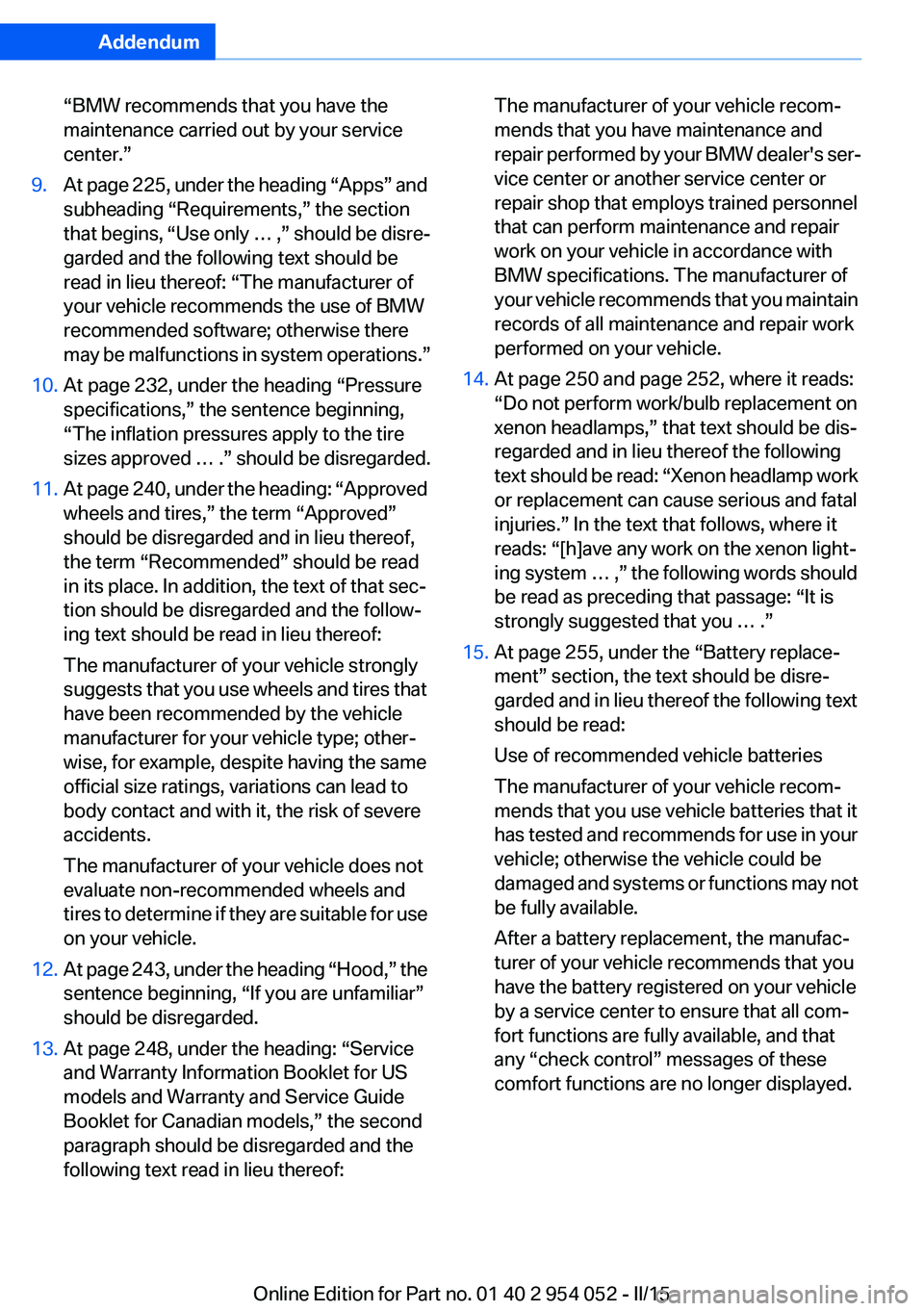
Addendum
“BMW recommends that you have the
maintenance carried out by your service
center.”
9. At page 225, under the heading “Apps” and
subheading “Requirements,” the section
that begins, “Use only … ,” should be disre-
garded and the following text should be
read in lieu thereof: “The manufacturer of
your vehicle recommends the use of BMW
recommended software; otherwise there
may be malfunctions in system operations.”
10. At page 232, under the heading “Pressure
specifications,” the sentence beginning,
“The inflation pressures apply to the tire
sizes approved … .” should be disregarded.
11. At page 240, under the heading: “Approved
wheels and tires,” the term “Approved”
should be disregarded and in lieu thereof,
the term “Recommended” should be read
in its place. In addition, the text of that sec-
tion should be disregarded and the follow-
ing text should be read in lieu thereof:
The manufacturer of your vehicle strongly
suggests that you use wheels and tires that
have been recommended by the vehicle
manufacturer for your vehicle type; other-
wise, for example, despite having the same
official size ratings, variations can lead to
body contact and with it, the risk of severe
accidents.
The manufacturer of your vehicle does not
evaluate non-recommended wheels and
tires to determine if they are suitable for use
on your vehicle.
12. At page 243, under the heading “Hood,” the
sentence beginning, “If you are unfamiliar”
should be disregarded.
13. At page 248, under the heading: “Service
and Warranty Information Booklet for US
models and Warranty and Service Guide
Booklet for Canadian models,” the second
paragraph should be disregarded and the
following text read in lieu thereof:
The manufacturer of your vehicle recom-
mends that you have maintenance and
repair performed by your BMW dealer's ser-
vice center or another service center or
repair shop that employs trained personnel
that can perform maintenance and repair
work on your vehicle in accordance with
BMW specifications. The manufacturer of
your vehicle recommends that you maintain
records of all maintenance and repair work
performed on your vehicle.
14. At page 250 and page 252, where it reads:
“Do not perform work/bulb replacement on
xenon headlamps,” that text should be dis-
regarded and in lieu thereof the following
text should be read: “Xenon headlamp work
or replacement can cause serious and fatal
injuries.” In the text that follows, where it
reads: “[h]ave any work on the xenon light-
ing system … ,” the following words should
be read as preceding that passage: “It is
strongly suggested that you … .”
15. At page 255, under the “Battery replace-
ment” section, the text should be disre-
garded and in lieu thereof the following text
should be read:
Use of recommended vehicle batteries
The manufacturer of your vehicle recom-
mends that you use vehicle batteries that it
has tested and recommends for use in your
vehicle; otherwise the vehicle could be
damaged and systems or functions may not
be fully available.
After a battery replacement, the manufac-
turer of your vehicle recommends that you
have the battery registered on your vehicle
by a service center to ensure that all com-
fort functions are fully available, and that
any “check control” messages of these
comfort functions are no longer displayed.
Online Edition for Part no. 01 40 2 954 052 - II/15
Page 99 of 297
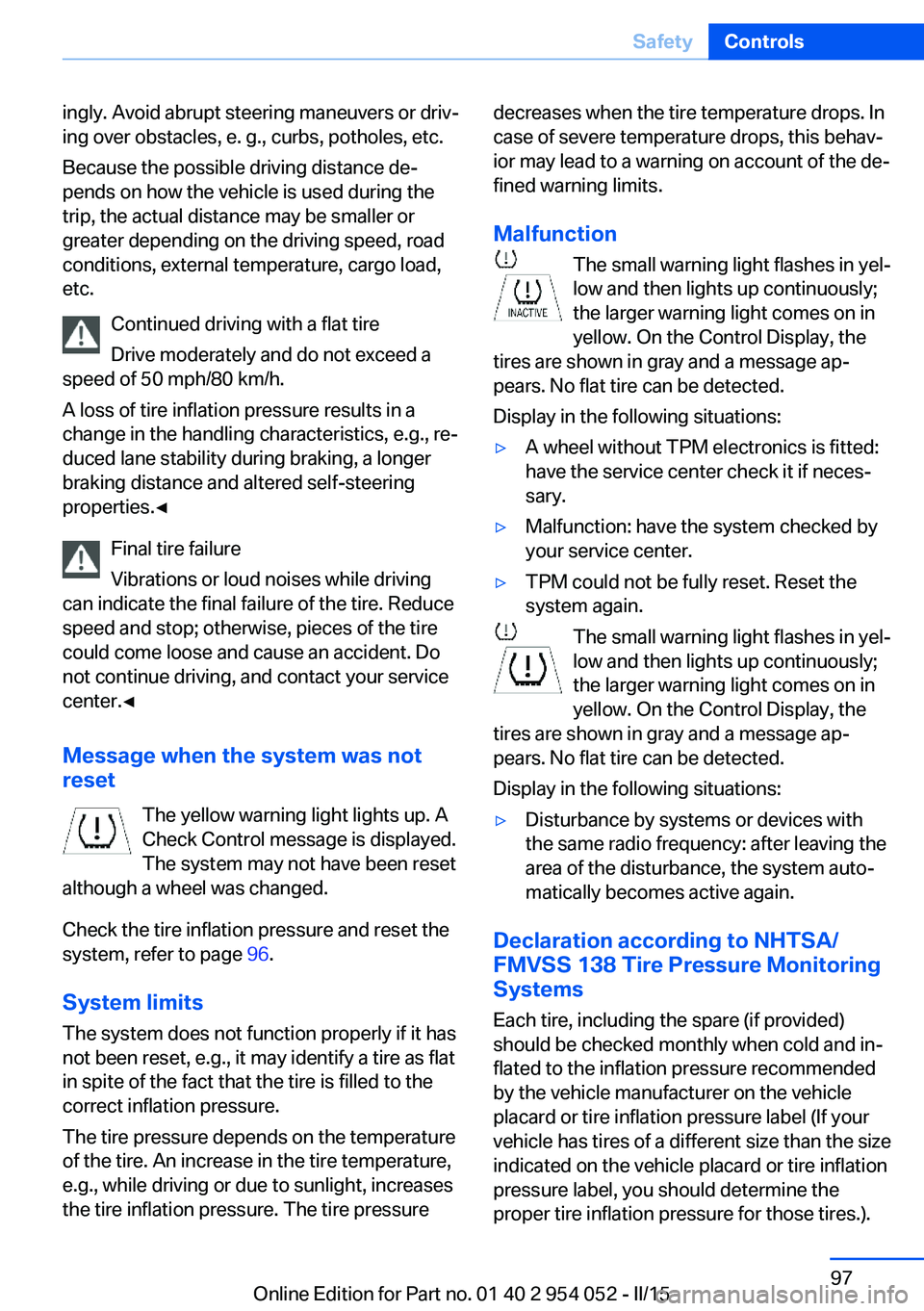
ingly. Avoid abrupt steering maneuvers or driv‐
ing over obstacles, e. g., curbs, potholes, etc.
Because the possible driving distance de‐
pends on how the vehicle is used during the
trip, the actual distance may be smaller or
greater depending on the driving speed, road
conditions, external temperature, cargo load,
etc.
Continued driving with a flat tire
Drive moderately and do not exceed a
speed of 50 mph/80 km/h.
A loss of tire inflation pressure results in a
change in the handling characteristics, e.g., re‐
duced lane stability during braking, a longer
braking distance and altered self-steering
properties.◀
Final tire failure
Vibrations or loud noises while driving
can indicate the final failure of the tire. Reduce
speed and stop; otherwise, pieces of the tire
could come loose and cause an accident. Do
not continue driving, and contact your service
center.◀
Message when the system was not
reset
The yellow warning light lights up. ACheck Control message is displayed.
The system may not have been reset
although a wheel was changed.
Check the tire inflation pressure and reset the
system, refer to page 96.
System limits
The system does not function properly if it has
not been reset, e.g., it may identify a tire as flat
in spite of the fact that the tire is filled to the
correct inflation pressure.
The tire pressure depends on the temperature
of the tire. An increase in the tire temperature,
e.g., while driving or due to sunlight, increases
the tire inflation pressure. The tire pressuredecreases when the tire temperature drops. In
case of severe temperature drops, this behav‐
ior may lead to a warning on account of the de‐
fined warning limits.
Malfunction The small warning light flashes in yel‐
low and then lights up continuously;
the larger warning light comes on in
yellow. On the Control Display, the
tires are shown in gray and a message ap‐
pears. No flat tire can be detected.
Display in the following situations:▷A wheel without TPM electronics is fitted:
have the service center check it if neces‐
sary.▷Malfunction: have the system checked by
your service center.▷TPM could not be fully reset. Reset the
system again.
The small warning light flashes in yel‐
low and then lights up continuously;
the larger warning light comes on in
yellow. On the Control Display, the
tires are shown in gray and a message ap‐
pears. No flat tire can be detected.
Display in the following situations:
▷Disturbance by systems or devices with
the same radio frequency: after leaving the
area of the disturbance, the system auto‐
matically becomes active again.
Declaration according to NHTSA/
FMVSS 138 Tire Pressure Monitoring
Systems
Each tire, including the spare (if provided)
should be checked monthly when cold and in‐
flated to the inflation pressure recommended
by the vehicle manufacturer on the vehicle
placard or tire inflation pressure label (If your
vehicle has tires of a different size than the size
indicated on the vehicle placard or tire inflation
pressure label, you should determine the
proper tire inflation pressure for those tires.).
Seite 97SafetyControls97
Online Edition for Part no. 01 40 2 954 052 - II/15
Page 234 of 297
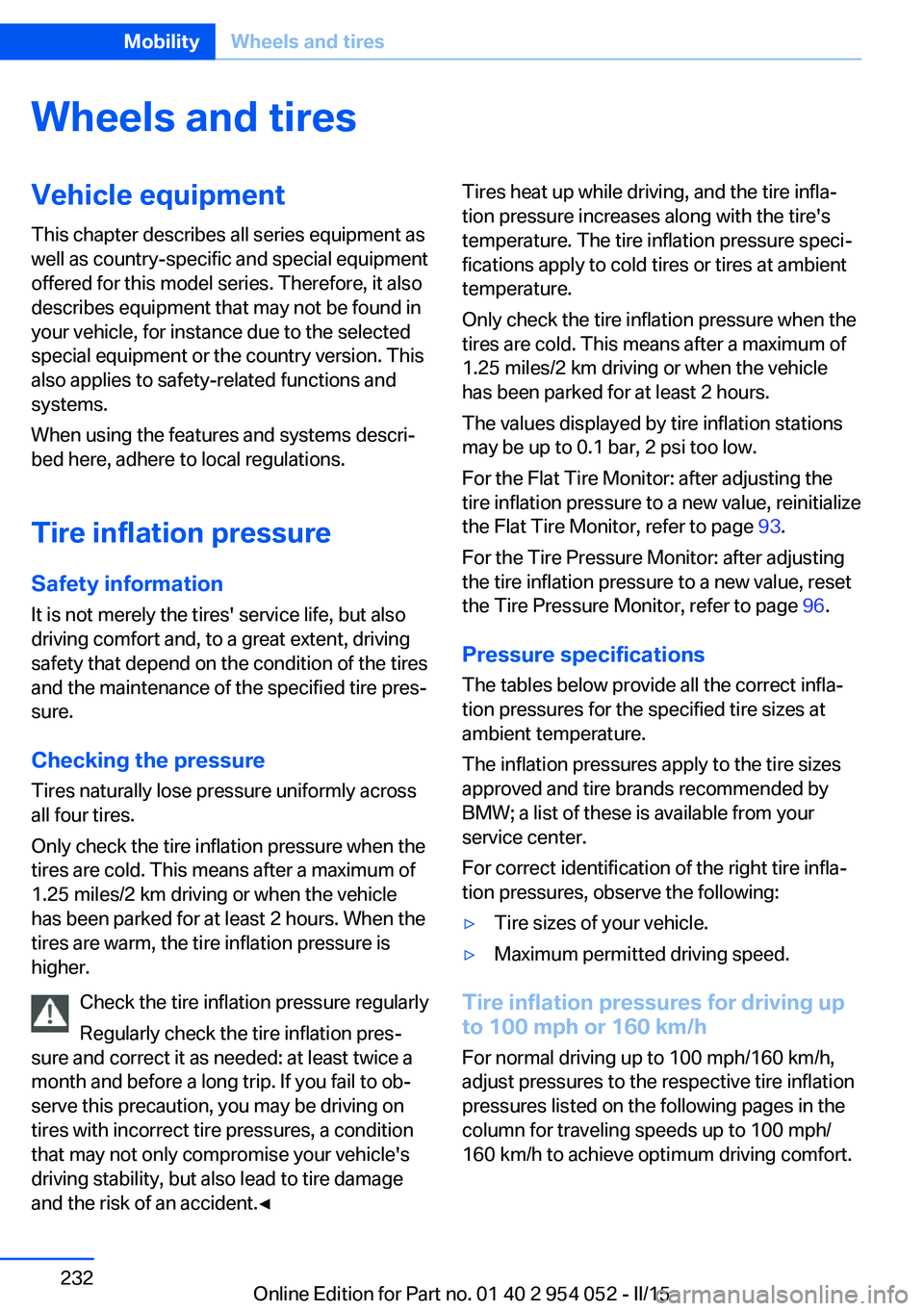
Wheels and tiresVehicle equipment
This chapter describes all series equipment as
well as country-specific and special equipment
offered for this model series. Therefore, it also
describes equipment that may not be found in
your vehicle, for instance due to the selected
special equipment or the country version. This
also applies to safety-related functions and
systems.
When using the features and systems descri‐
bed here, adhere to local regulations.
Tire inflation pressure Safety information
It is not merely the tires' service life, but also
driving comfort and, to a great extent, driving
safety that depend on the condition of the tires
and the maintenance of the specified tire pres‐
sure.
Checking the pressure Tires naturally lose pressure uniformly across
all four tires.
Only check the tire inflation pressure when the
tires are cold. This means after a maximum of
1.25 miles/2 km driving or when the vehicle
has been parked for at least 2 hours. When the
tires are warm, the tire inflation pressure is
higher.
Check the tire inflation pressure regularly
Regularly check the tire inflation pres‐
sure and correct it as needed: at least twice a
month and before a long trip. If you fail to ob‐
serve this precaution, you may be driving on
tires with incorrect tire pressures, a condition
that may not only compromise your vehicle's
driving stability, but also lead to tire damage
and the risk of an accident.◀Tires heat up while driving, and the tire infla‐
tion pressure increases along with the tire's
temperature. The tire inflation pressure speci‐
fications apply to cold tires or tires at ambient
temperature.
Only check the tire inflation pressure when the
tires are cold. This means after a maximum of
1.25 miles/2 km driving or when the vehicle
has been parked for at least 2 hours.
The values displayed by tire inflation stations
may be up to 0.1 bar, 2 psi too low.
For the Flat Tire Monitor: after adjusting the
tire inflation pressure to a new value, reinitialize
the Flat Tire Monitor, refer to page 93.
For the Tire Pressure Monitor: after adjusting
the tire inflation pressure to a new value, reset
the Tire Pressure Monitor, refer to page 96.
Pressure specifications The tables below provide all the correct infla‐
tion pressures for the specified tire sizes at
ambient temperature.
The inflation pressures apply to the tire sizes
approved and tire brands recommended by
BMW; a list of these is available from your
service center.
For correct identification of the right tire infla‐
tion pressures, observe the following:▷Tire sizes of your vehicle.▷Maximum permitted driving speed.
Tire inflation pressures for driving up
to 100 mph or 160 km/h
For normal driving up to 100 mph/160 km/h,
adjust pressures to the respective tire inflation
pressures listed on the following pages in the
column for traveling speeds up to 100 mph/
160 km/h to achieve optimum driving comfort.
Seite 232MobilityWheels and tires232
Online Edition for Part no. 01 40 2 954 052 - II/15
Page 235 of 297
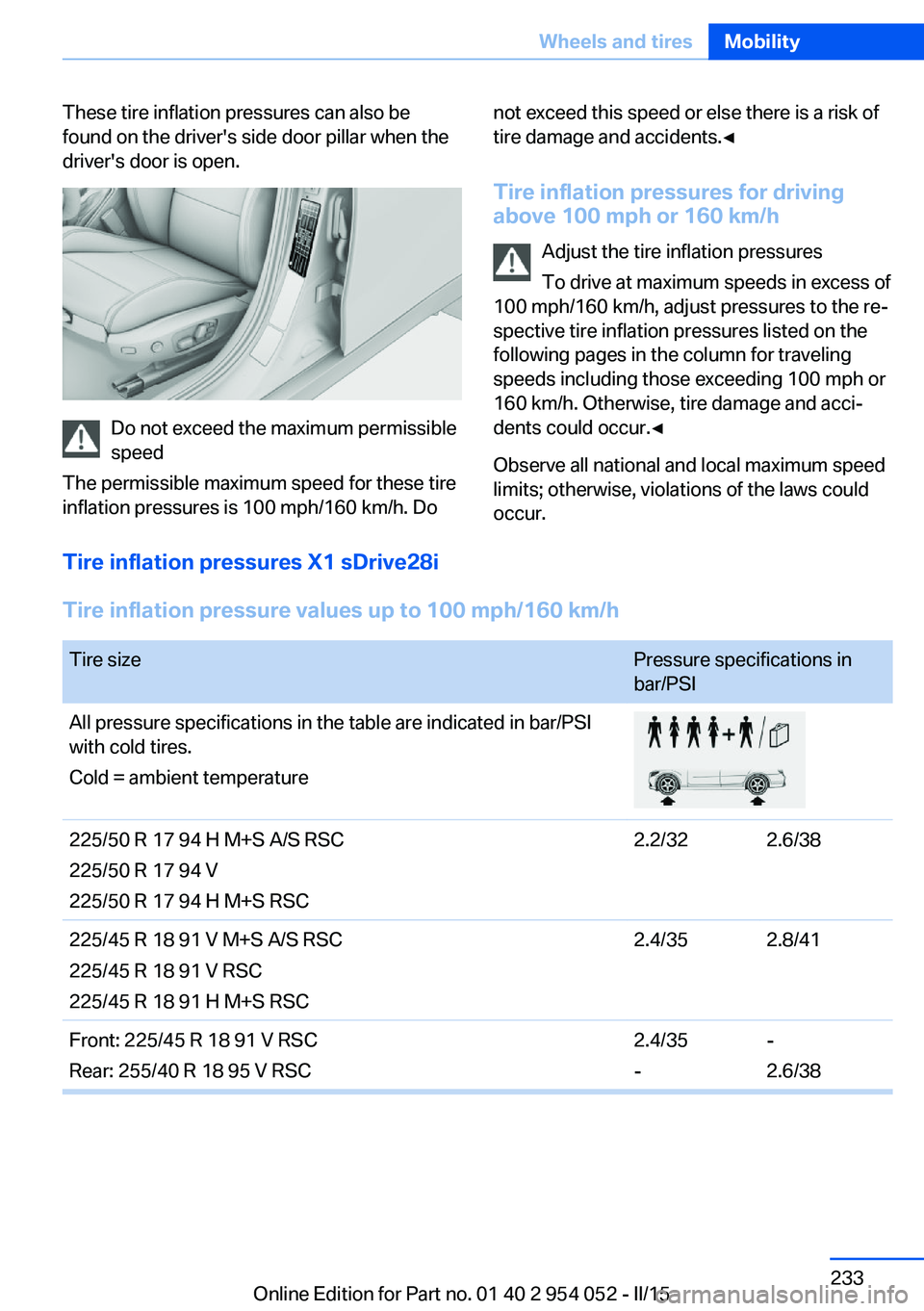
These tire inflation pressures can also be
found on the driver's side door pillar when the
driver's door is open.
Do not exceed the maximum permissible
speed
The permissible maximum speed for these tire
inflation pressures is 100 mph/160 km/h. Do
not exceed this speed or else there is a risk of
tire damage and accidents.◀
Tire inflation pressures for driving
above 100 mph or 160 km/h
Adjust the tire inflation pressures
To drive at maximum speeds in excess of
100 mph/160 km/h, adjust pressures to the re‐
spective tire inflation pressures listed on the
following pages in the column for traveling
speeds including those exceeding 100 mph or
160 km/h. Otherwise, tire damage and acci‐
dents could occur.◀
Observe all national and local maximum speed
limits; otherwise, violations of the laws could
occur.
Tire inflation pressures X1 sDrive28i
Tire inflation pressure values up to 100 mph/160 km/h
Tire sizePressure specifications in
bar/PSIAll pressure specifications in the table are indicated in bar/PSI
with cold tires.
Cold = ambient temperature225/50 R 17 94 H M+S A/S RSC
225/50 R 17 94 V
225/50 R 17 94 H M+S RSC2.2/322.6/38225/45 R 18 91 V M+S A/S RSC
225/45 R 18 91 V RSC
225/45 R 18 91 H M+S RSC2.4/352.8/41Front: 225/45 R 18 91 V RSC
Rear: 255/40 R 18 95 V RSC2.4/35
--
2.6/38Seite 233Wheels and tiresMobility233
Online Edition for Part no. 01 40 2 954 052 - II/15
Page 236 of 297
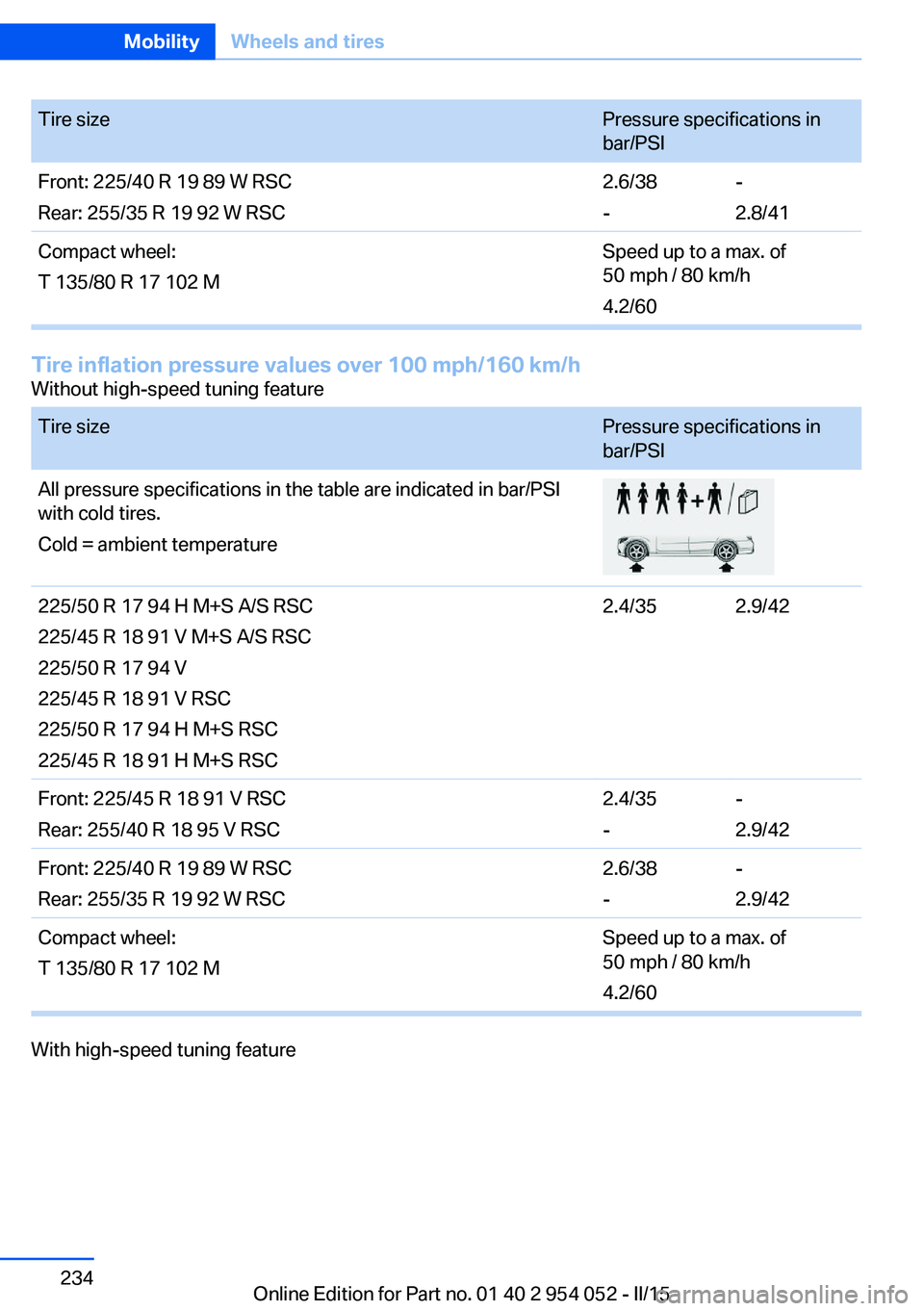
Tire sizePressure specifications in
bar/PSIFront: 225/40 R 19 89 W RSC
Rear: 255/35 R 19 92 W RSC2.6/38
--
2.8/41Compact wheel:
T 135/80 R 17 102 MSpeed up to a max. of
50 mph / 80 km/h
4.2/60
Tire inflation pressure values over 100 mph/160 km/h
Without high-speed tuning feature Tire sizePressure specifications in
bar/PSIAll pressure specifications in the table are indicated in bar/PSI
with cold tires.
Cold = ambient temperature225/50 R 17 94 H M+S A/S RSC
225/45 R 18 91 V M+S A/S RSC
225/50 R 17 94 V
225/45 R 18 91 V RSC
225/50 R 17 94 H M+S RSC
225/45 R 18 91 H M+S RSC2.4/352.9/42Front: 225/45 R 18 91 V RSC
Rear: 255/40 R 18 95 V RSC2.4/35
--
2.9/42Front: 225/40 R 19 89 W RSC
Rear: 255/35 R 19 92 W RSC2.6/38
--
2.9/42Compact wheel:
T 135/80 R 17 102 MSpeed up to a max. of
50 mph / 80 km/h
4.2/60With high-speed tuning featureSeite 234MobilityWheels and tires234
Online Edition for Part no. 01 40 2 954 052 - II/15
Page 237 of 297
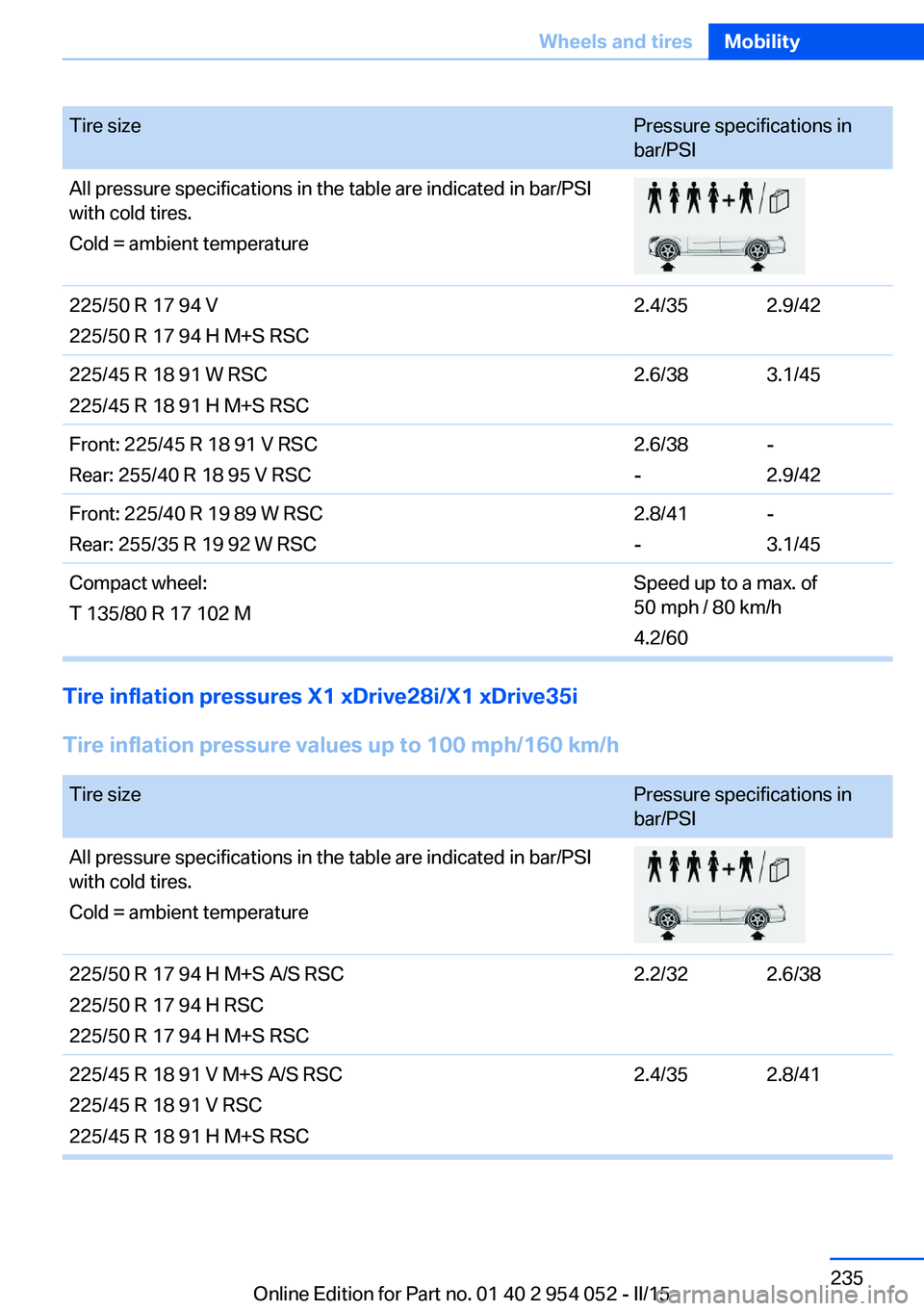
Tire sizePressure specifications in
bar/PSIAll pressure specifications in the table are indicated in bar/PSI
with cold tires.
Cold = ambient temperature225/50 R 17 94 V
225/50 R 17 94 H M+S RSC2.4/352.9/42225/45 R 18 91 W RSC
225/45 R 18 91 H M+S RSC2.6/383.1/45Front: 225/45 R 18 91 V RSC
Rear: 255/40 R 18 95 V RSC2.6/38
--
2.9/42Front: 225/40 R 19 89 W RSC
Rear: 255/35 R 19 92 W RSC2.8/41
--
3.1/45Compact wheel:
T 135/80 R 17 102 MSpeed up to a max. of
50 mph / 80 km/h
4.2/60
Tire inflation pressures X1 xDrive28i/X1 xDrive35i
Tire inflation pressure values up to 100 mph/160 km/h
Tire sizePressure specifications in
bar/PSIAll pressure specifications in the table are indicated in bar/PSI
with cold tires.
Cold = ambient temperature225/50 R 17 94 H M+S A/S RSC
225/50 R 17 94 H RSC
225/50 R 17 94 H M+S RSC2.2/322.6/38225/45 R 18 91 V M+S A/S RSC
225/45 R 18 91 V RSC
225/45 R 18 91 H M+S RSC2.4/352.8/41Seite 235Wheels and tiresMobility235
Online Edition for Part no. 01 40 2 954 052 - II/15
Page 238 of 297
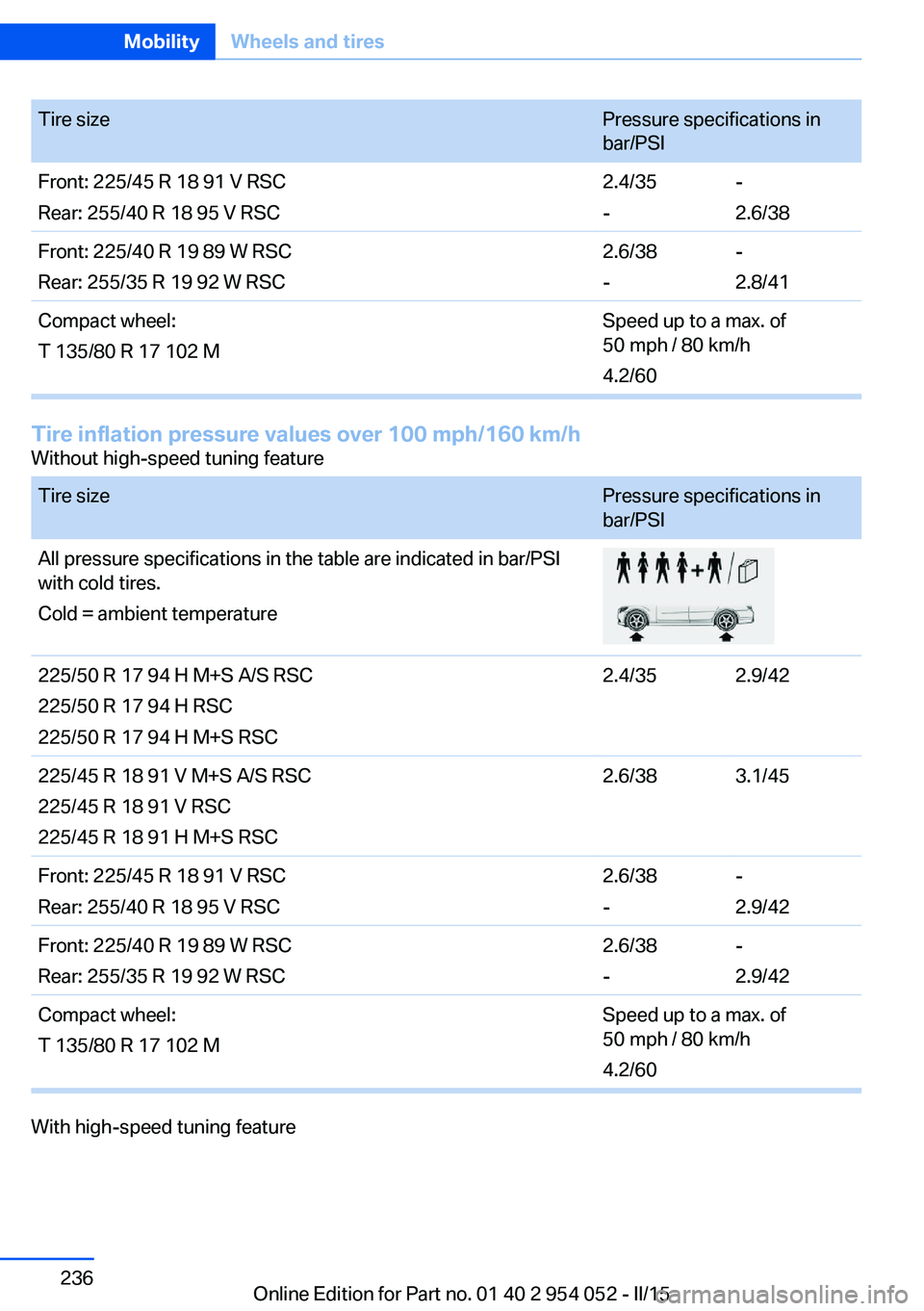
Tire sizePressure specifications in
bar/PSIFront: 225/45 R 18 91 V RSC
Rear: 255/40 R 18 95 V RSC2.4/35
--
2.6/38Front: 225/40 R 19 89 W RSC
Rear: 255/35 R 19 92 W RSC2.6/38
--
2.8/41Compact wheel:
T 135/80 R 17 102 MSpeed up to a max. of
50 mph / 80 km/h
4.2/60
Tire inflation pressure values over 100 mph/160 km/h
Without high-speed tuning feature Tire sizePressure specifications in
bar/PSIAll pressure specifications in the table are indicated in bar/PSI
with cold tires.
Cold = ambient temperature225/50 R 17 94 H M+S A/S RSC
225/50 R 17 94 H RSC
225/50 R 17 94 H M+S RSC2.4/352.9/42225/45 R 18 91 V M+S A/S RSC
225/45 R 18 91 V RSC
225/45 R 18 91 H M+S RSC2.6/383.1/45Front: 225/45 R 18 91 V RSC
Rear: 255/40 R 18 95 V RSC2.6/38
--
2.9/42Front: 225/40 R 19 89 W RSC
Rear: 255/35 R 19 92 W RSC2.6/38
--
2.9/42Compact wheel:
T 135/80 R 17 102 MSpeed up to a max. of
50 mph / 80 km/h
4.2/60With high-speed tuning featureSeite 236MobilityWheels and tires236
Online Edition for Part no. 01 40 2 954 052 - II/15
Page 239 of 297
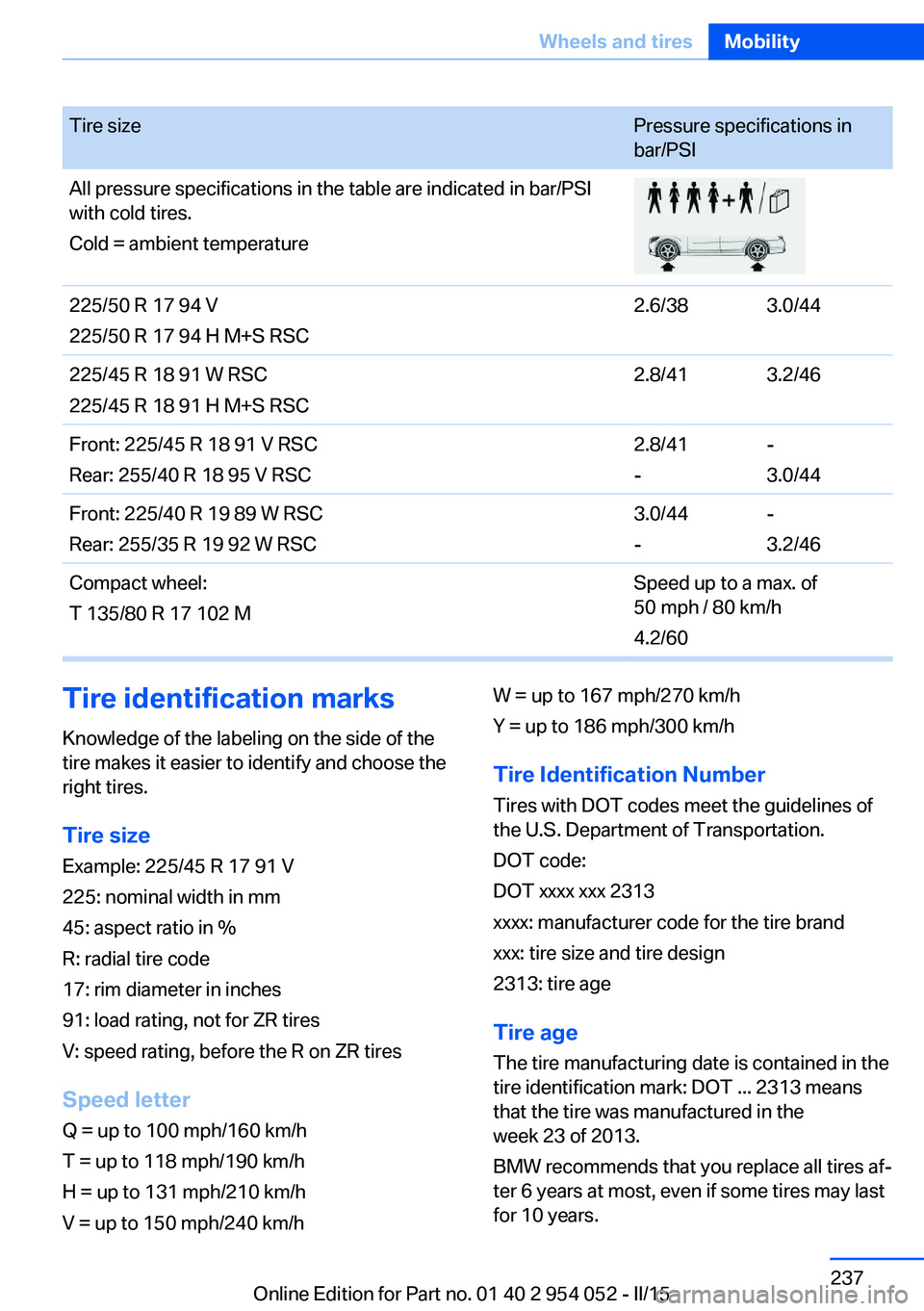
Tire sizePressure specifications in
bar/PSIAll pressure specifications in the table are indicated in bar/PSI
with cold tires.
Cold = ambient temperature225/50 R 17 94 V
225/50 R 17 94 H M+S RSC2.6/383.0/44225/45 R 18 91 W RSC
225/45 R 18 91 H M+S RSC2.8/413.2/46Front: 225/45 R 18 91 V RSC
Rear: 255/40 R 18 95 V RSC2.8/41
--
3.0/44Front: 225/40 R 19 89 W RSC
Rear: 255/35 R 19 92 W RSC3.0/44
--
3.2/46Compact wheel:
T 135/80 R 17 102 MSpeed up to a max. of
50 mph / 80 km/h
4.2/60Tire identification marks
Knowledge of the labeling on the side of the
tire makes it easier to identify and choose the
right tires.
Tire size
Example: 225/45 R 17 91 V
225: nominal width in mm
45: aspect ratio in %
R: radial tire code
17: rim diameter in inches
91: load rating, not for ZR tires
V: speed rating, before the R on ZR tires
Speed letter
Q = up to 100 mph/160 km/h
T = up to 118 mph/190 km/h
H = up to 131 mph/210 km/h
V = up to 150 mph/240 km/hW = up to 167 mph/270 km/h
Y = up to 186 mph/300 km/h
Tire Identification Number Tires with DOT codes meet the guidelines of
the U.S. Department of Transportation.
DOT code:
DOT xxxx xxx 2313
xxxx: manufacturer code for the tire brand
xxx: tire size and tire design
2313: tire age
Tire age
The tire manufacturing date is contained in the
tire identification mark: DOT ... 2313 means
that the tire was manufactured in the
week 23 of 2013.
BMW recommends that you replace all tires af‐
ter 6 years at most, even if some tires may last
for 10 years.Seite 237Wheels and tiresMobility237
Online Edition for Part no. 01 40 2 954 052 - II/15
Page 242 of 297
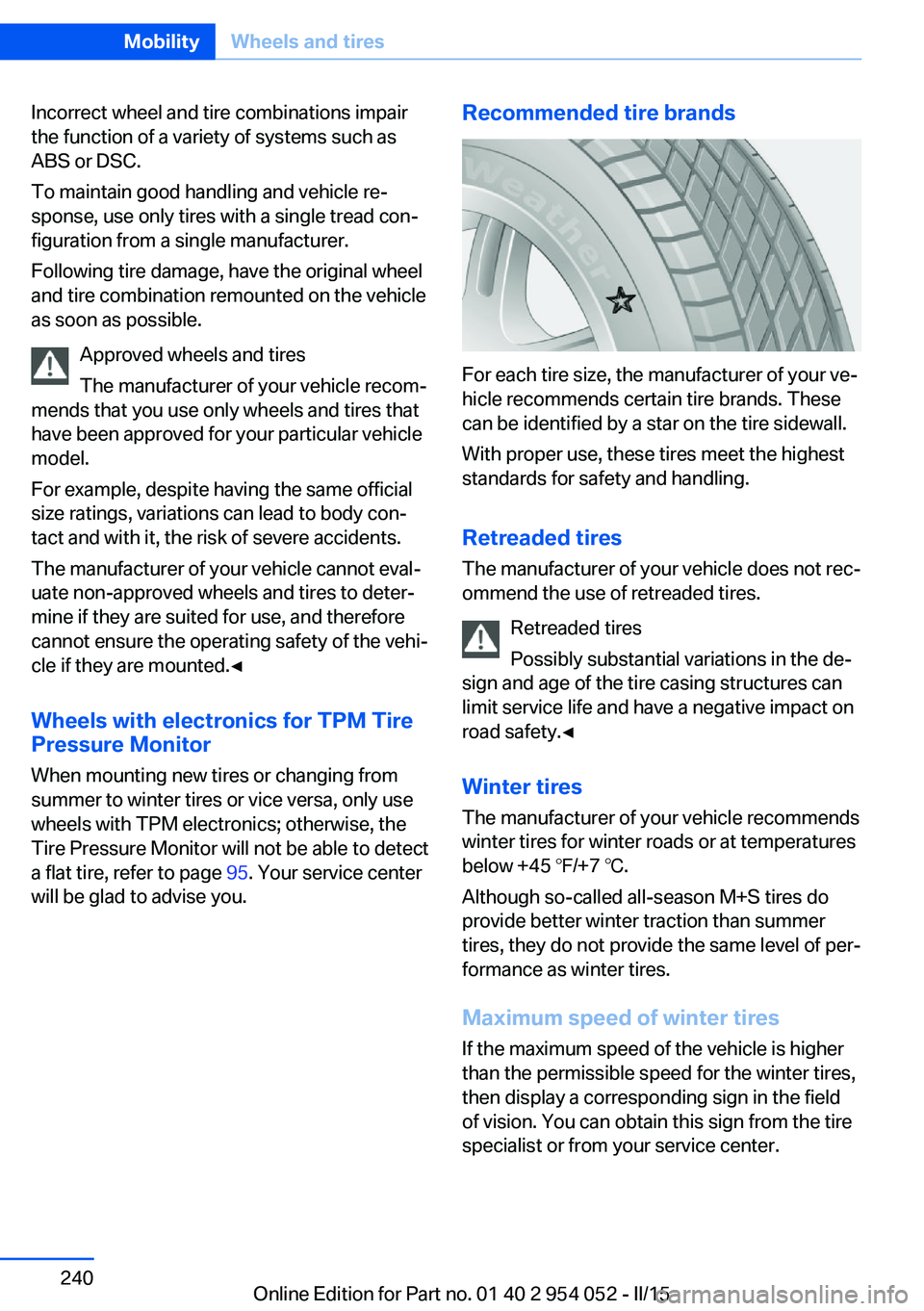
Incorrect wheel and tire combinations impair
the function of a variety of systems such as
ABS or DSC.
To maintain good handling and vehicle re‐
sponse, use only tires with a single tread con‐
figuration from a single manufacturer.
Following tire damage, have the original wheel
and tire combination remounted on the vehicle
as soon as possible.
Approved wheels and tires
The manufacturer of your vehicle recom‐
mends that you use only wheels and tires that
have been approved for your particular vehicle
model.
For example, despite having the same official
size ratings, variations can lead to body con‐
tact and with it, the risk of severe accidents.
The manufacturer of your vehicle cannot eval‐
uate non-approved wheels and tires to deter‐
mine if they are suited for use, and therefore
cannot ensure the operating safety of the vehi‐
cle if they are mounted.◀
Wheels with electronics for TPM Tire
Pressure Monitor
When mounting new tires or changing from
summer to winter tires or vice versa, only use
wheels with TPM electronics; otherwise, the
Tire Pressure Monitor will not be able to detect
a flat tire, refer to page 95. Your service center
will be glad to advise you.Recommended tire brands
For each tire size, the manufacturer of your ve‐
hicle recommends certain tire brands. These
can be identified by a star on the tire sidewall.
With proper use, these tires meet the highest
standards for safety and handling.
Retreaded tires The manufacturer of your vehicle does not rec‐
ommend the use of retreaded tires.
Retreaded tires
Possibly substantial variations in the de‐
sign and age of the tire casing structures can
limit service life and have a negative impact on
road safety.◀
Winter tires
The manufacturer of your vehicle recommends
winter tires for winter roads or at temperatures
below +45 ℉/+7 ℃.
Although so-called all-season M+S tires do
provide better winter traction than summer tires, they do not provide the same level of per‐
formance as winter tires.
Maximum speed of winter tires
If the maximum speed of the vehicle is higher
than the permissible speed for the winter tires,
then display a corresponding sign in the field
of vision. You can obtain this sign from the tire
specialist or from your service center.
Seite 240MobilityWheels and tires240
Online Edition for Part no. 01 40 2 954 052 - II/15
Page 292 of 297
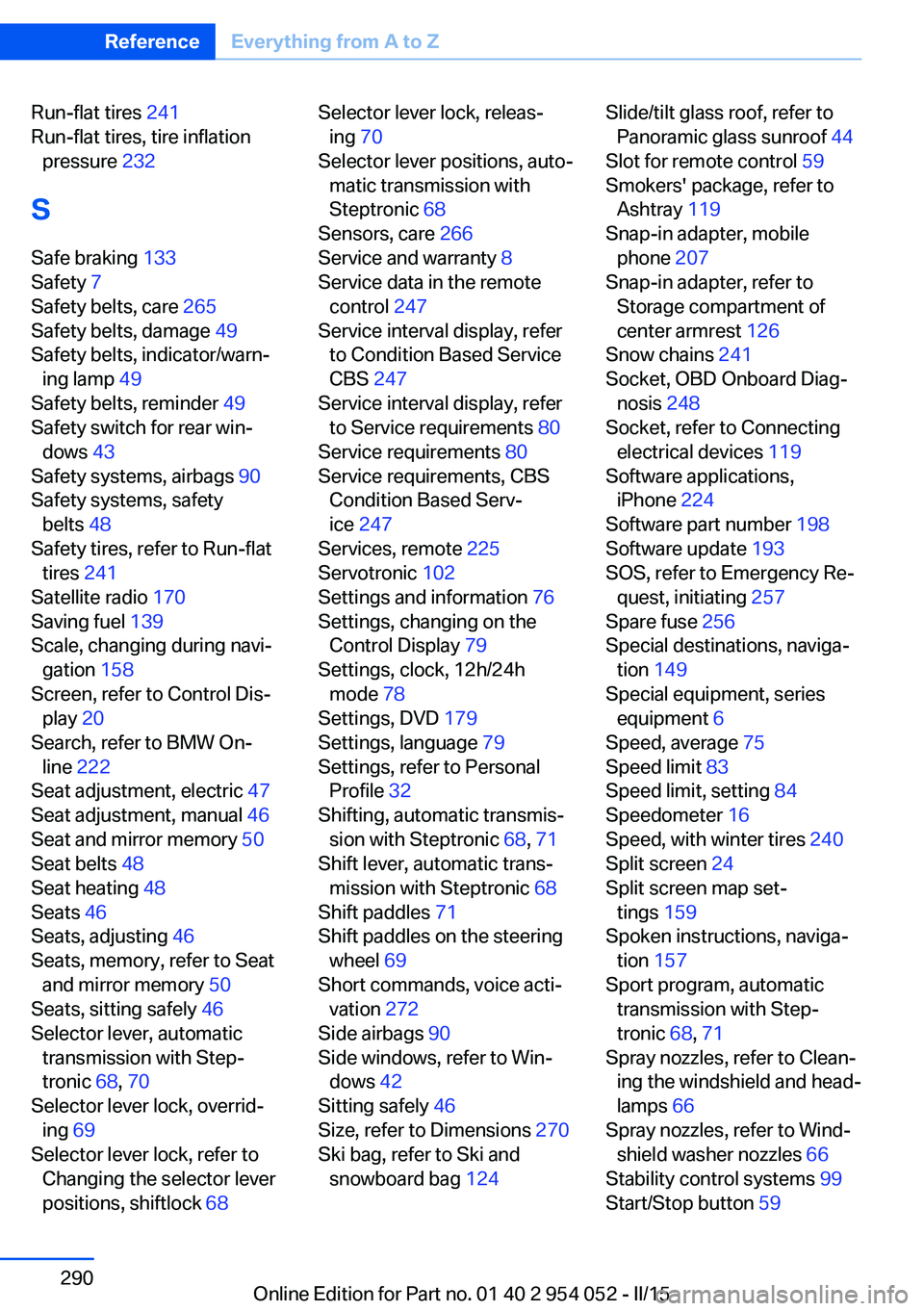
Run-flat tires 241
Run-flat tires, tire inflation pressure 232
S Safe braking 133
Safety 7
Safety belts, care 265
Safety belts, damage 49
Safety belts, indicator/warn‐ ing lamp 49
Safety belts, reminder 49
Safety switch for rear win‐ dows 43
Safety systems, airbags 90
Safety systems, safety belts 48
Safety tires, refer to Run-flat tires 241
Satellite radio 170
Saving fuel 139
Scale, changing during navi‐ gation 158
Screen, refer to Control Dis‐ play 20
Search, refer to BMW On‐ line 222
Seat adjustment, electric 47
Seat adjustment, manual 46
Seat and mirror memory 50
Seat belts 48
Seat heating 48
Seats 46
Seats, adjusting 46
Seats, memory, refer to Seat and mirror memory 50
Seats, sitting safely 46
Selector lever, automatic transmission with Step‐
tronic 68, 70
Selector lever lock, overrid‐ ing 69
Selector lever lock, refer to Changing the selector lever
positions, shiftlock 68 Selector lever lock, releas‐
ing 70
Selector lever positions, auto‐ matic transmission with
Steptronic 68
Sensors, care 266
Service and warranty 8
Service data in the remote control 247
Service interval display, refer to Condition Based Service
CBS 247
Service interval display, refer to Service requirements 80
Service requirements 80
Service requirements, CBS Condition Based Serv‐
ice 247
Services, remote 225
Servotronic 102
Settings and information 76
Settings, changing on the Control Display 79
Settings, clock, 12h/24h mode 78
Settings, DVD 179
Settings, language 79
Settings, refer to Personal Profile 32
Shifting, automatic transmis‐ sion with Steptronic 68, 71
Shift lever, automatic trans‐ mission with Steptronic 68
Shift paddles 71
Shift paddles on the steering wheel 69
Short commands, voice acti‐ vation 272
Side airbags 90
Side windows, refer to Win‐ dows 42
Sitting safely 46
Size, refer to Dimensions 270
Ski bag, refer to Ski and snowboard bag 124 Slide/tilt glass roof, refer to
Panoramic glass sunroof 44
Slot for remote control 59
Smokers' package, refer to Ashtray 119
Snap-in adapter, mobile phone 207
Snap-in adapter, refer to Storage compartment of
center armrest 126
Snow chains 241
Socket, OBD Onboard Diag‐ nosis 248
Socket, refer to Connecting electrical devices 119
Software applications, iPhone 224
Software part number 198
Software update 193
SOS, refer to Emergency Re‐ quest, initiating 257
Spare fuse 256
Special destinations, naviga‐ tion 149
Special equipment, series equipment 6
Speed, average 75
Speed limit 83
Speed limit, setting 84
Speedometer 16
Speed, with winter tires 240
Split screen 24
Split screen map set‐ tings 159
Spoken instructions, naviga‐ tion 157
Sport program, automatic transmission with Step‐
tronic 68, 71
Spray nozzles, refer to Clean‐ ing the windshield and head‐
lamps 66
Spray nozzles, refer to Wind‐ shield washer nozzles 66
Stability control systems 99
Start/Stop button 59 Seite 290ReferenceEverything from A to Z290
Online Edition for Part no. 01 40 2 954 052 - II/15